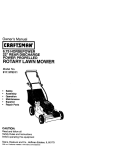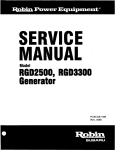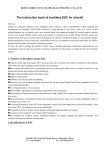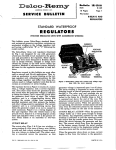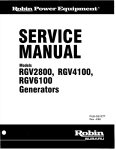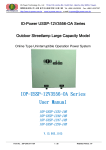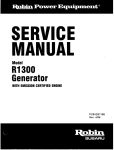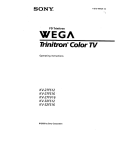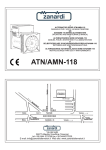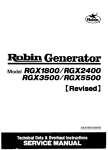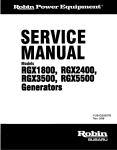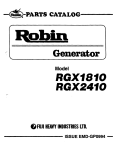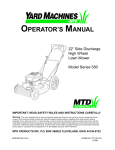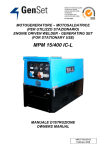Download R1210 GENERATOR SERVICE MANUAL
Transcript
LEGENERATOR 210~ CONTENTS Page Section 1. SPECIFICATIONS 2. PERFORMANCE 2-1 CURVES ............................................................... AC Output .............................................................................. 2-2 DC Output .............................................................................. 3. FEATURES .................................................................................. 4. GENERAL DESCRIPTION OF THE GENERATOR .................................. 4-1 1 .......................................................................... External View of Generator 2 2 3 4 5 ........................................................... 5 4-2 Location of Serial Number and Specification Number ............................... CONSTRUCTlON AND FUNCTION ..................................................... 5. 5-1 Construction ........................................................................... 5-2 6 7 7 7 Function ................................................................................ 6. 5-3 Description of Generator Operation ................................................ SAFETY PRECAUTIONS ................................................................ 12 7. RANGE 13 OF APPLICATIONS 8. MEASURING ............................................................ PROCEDURES .......................................................... 10 17 Measuring Instruments ............................................................... 8-2 AC Output Measuring ................................................................ 17 20 8-3 DC Output Measuring ............................................................... 20 8-1 8-4 Measuring Insulation resistance ..................................................... FUNCTIONAL MEMBERS ............................................... 9. CHECKING Control panel.. ........................................................................ 9-1 21 23 23 9-2 Stator .................................................................................. 24 9-3 Rotor .................................................................................. 25 9-4 Condenser 26 9-5 Diode ............................................................................ Rectifier ........................................................................ 10. DISASSEMBLY AND ASSEMBLY .................................................... 10-1 Preparation and Precautions ........................................................ 10-2 10-3 Disassembly Procedures ............................................................. Assembly procedures ................................................................ 11. TROUBLE SHOOTING 11-1 No AC Output. 11-2 AC voltage 12. WIRING is too DIAGRAM .................................................................. ....................................................................... high or too low ................................................... ...................................................................... 26 2 7 27 28 38 44 44 46 47 S E R \/I Rk C E RG-32 September-1995 NEWS Generators @ FUJIHEAVY INDUSTRIES LTD. INDUSTRIAL PRODUCTS DIV. I MODEL SUBJECT I R1210 Oil Sensorchange This Service News is to inform of the change of the oil sensorand wiring equipped with the ROBIN engine EY 15 for R1210 generator set. 1. Purpose To improve the performance of the oil sensor. 2. Main points of the modification 1) The oil level sensing mechanism of the oil sensoris changedfrom piezo-resonator type to potentiometer type. 2) The electric wiring and clamp are also changed. 3. Change of part number - For the detail, refer to the attached figures. New Parts set NO. 1. 2. 3. Part Name Oil sensor CP.6 Wire 7 CP. Clamp Current parts set NO. Part name 4. 5. 6. Oil level sensor CP. Wire 22 CP. Clamp CP. Part number KS3-11015-01 227-73 107-O1 056-60002-50 +?k Parl number 227-76035-01 214-73122-01 206-75501-01 Q’tv 1 1 1 1 1 Interchangeability It is interchangeableonly when the all parts are replaced as a set; that is to say, the current parts set (item NO.4 to 6) can be replaced with new parts set (item NO. 1 to 3). However, there is no interchangeability for the individual part. 4. Execution This oil sensorchangeis adoptedto the new ROBIN generatorset to be produced in and after September 1995. -1- I Attachment (A); oil sensorinstallation change New installation *:Clamping in detail Current installation Attachment (B) 1. Oil sensorchange New Current OIL SENSOR CP 6 KS3-11015-01 OIL LEVEL SENSOR CP 227-76035-01 -3- 2. Electric wiring change New wIRE7CP. 227-73107-01 Current wm 22 cP . 214-73122-01 3. Clamp change New CLAMP 056-60002-50 d 6.5 Current CLAMP CP. 206-75501-01 3I \ +IA J-c \ I I A -3 Section A-A -4- 1. SPECIFICATIONS Generator Bushless, self-exciting, revolving field Type Frequency AC Voltage (Rated current) 2-pole, single phase, 50 Hz 60 Hz 11 OV (7.3 A) 11OV (9.1 A) 220V (3.6 A) 12OV (8.3 A) 230V (3.5 A) 220V (4.5 A) 240V (3.3 A) Max. / Rated / Engine 1000 w 1200 w 800 W 1000 w AC Output : DC Output 12V-8.3A(lOOW) Voltage regulation system Condenser system Type ’ Forced air-cooled, 4-stroke, side valve, gasoline engine Displacement , 143 cc (6.73 cu. in) 63 x 46 mm (2.48 x 1.81 in) Bore x Stroke I Automotive gasoline I Fuel ! Fuel tank capacity 3.5 liters (0.9 U.S. gal) Oil pan capacity 600 cc (1.3 U.S. pints) Rated continuous operating hours Dimensions (L X W X H) ; 486 x 288 x 410 mm (19.1 x 11.3 X 16.1 in.) 27.5 kg (60.6 Ibs.) Dry weight -5- 2. PERFORMANCE CURVES 2-1 AC OUTPUT >^ 240 E 59 220 9 800 Frequency ........................ 50Hz ........................... 220v 200 1, I I $ F t i? 05 I A 55 5 6 3 s E 1(-J)()w 8OOW Voltage 600 2 Output Max. ...................... Rated ..................... 5 400 50 45 0 200 1 0 2 3 CURRENT(A) 4 5 Output Max. ...................... Rated .................... Frequency ........................ Voltage ........................... 600 =g i= 400 oI;i 1 200 2 3 CURRENT(A) 4 5 0 -2- z s 12o()w ,oooW 60~~ 12ov DC OUTPUT m voltage ......................... DC Ampere ......................... DC output ......................... ,2v 8.3A ,()ow The voltage curve shown in the left indicates the characteristic of DC output when charging a battery. The voltage may be decreased by 20% when the resistance load is applied. I 0 2 4 CURRENT 6 (A) - 8 10 -3- 3. FEATURES 3-l BRUSHLESS ALTERNATOR New brushless alternator has put an end to costly brush maintenance and down time. 3-2 CONDENSER VOLTAGE REGULATOR Condenser voltage regulation ensures stable voltage output under all working conditions. 3-3 COMPACT, LIGHTWEIGHT, CARRYING EASE As the new burshless alternator makes the Robin R1210 lightest in the class at 27.5 kgs, you can easily carry it around using the convenient carrying handle. 34 EASY OPERATION One-touch engine control switch integrates engine on/off switch and choke lever. All controls are conveniently concentrated on the front panel. 3-5 LONG CONTINUOUS OPERATION The large 3.5 liters fuel tank allows four hours of operation at 50Hz rated output. 3-5 MINIMAL MAINTENANCE Brushless alternator eliminates time consuming brush maintenance. Trouble-free condenser voltage regulation for greater dependability. No-fuse resettable circuit breakers. 0 Electronic pointless ignition system for sure starts. l l l 3-7 LONG LIFE DURABILITY Tough, heavy-duty Robin EY15 engine incorporates a cast iron cylinder liner, forged steel crankshaft and two main ball bearings for longer service life. 0 The brushless alternator dose not have any expendable parts such as brushes and slip rings or fragile circuit board assuring trouble-free operation for longer service life. l -4- 4. GENERAL DESCRIPTION OF THE GENERATOR 4-1 EXTERNAL VIEW of GENERATOR Engine Control Switch (CHOKE-RUN-STOP) DC Circuit Breaker AC Receptacle Ground Terminal Air Cleaner Cover Carrying Handle Spark Plug Cover - Fuel Tank / \- Drain Plug -5- Oil Filler Cap Fuel Tank Cap 4-2 LOCATION of SERIAL NUMBER and SPECIFICATION NUMBER Serial number and specification number are stamped on the LABEL(MODEL cover. NAME)stuck on the rear NOTE: Always specify these numbers when inquiring about the generator or ordering spare parts in order to get correct parts and accurate service. LABEL (SPEC.) / / LABEL (MODEL [Example] r PROD. NO. RGOl2216010-* 1234 1000001 1 SER. NO. L 4 L Specification Production Serial No. -6- No. No. 5. CONSTRUCTION AND FUNCTION 5-1 CONSTRUCTION ROTOR COMPLETE END COVER tip Co”PLER y- REAR YOVER , STATOR COMPLETE \ \ , i ’ DlODi RECTIFIER : , BALL BLARING STATOR COVER ; CONDiNSER THROtiGH MOUNT &BBER I I BOLT FRONT ~&OVER Fig. 5-7 5-2 FUNCTION 5-2-i STATOR The stator consists of a laminated silicon steel sheet core, a main coil and a condenser coil which are wound in the core slots. The condenser coil excites the rotor field coil which generates AC voltage in the main coil. I I I I I Fig. 5-2 -7- 5-2-2 CONDENSER I A condenser is mounted on the rear cover and is connected to the condenser coil which is wound on the stator. This condenser and condenser coil regulate the output voltage. Fig. 5-3 5-2-3 ROTOR The rotor consists of a laminated silicon steel sheet core and field coil which is wound over the core. DC current in the field coil magnetizes the steel sheet core. Two permanent magnets are provided for the primary exciting action. A cooling fan is pressure-fitted on the end of the rotor shaft to cool the coils, cores, rectifier, and other generator parts. (See Fig. 5-4) Fig. 5-4 A diode rectifier and resister are mounted inside of the insulator. (See Fig. 5-5) Cooling air is sucked by the rotor fan through the slits of the rear cover and is expelled through the outlets of the front cover. DE RECTIFIER Fig. 5-5 -8- 5-2-4 CONTROL PANEL The control panel has a double AC receptacle with a ground terminal, and a DC receptacle. The voltmeter displays output voltage of the generator. The circuit breaker for AC and DC in the upper section of the control panel protects the generator from getting damages caused by overloading or defective appliance. I Fig. 5-6 -9- 5-3 DESCRIPTION of GENERATOR OPERATION INITIAL EXCITATION PERMANENT MAGNETO FIELD STATOR COIL ROTOR 7 ----_---It RESISTOR or / r- --- MAIN DIODE COIL CONDENSER COIL Fig. 5-7 5-3-l GENERATION of NO-LOAD VOLTAGE (1) When the generator starts running, the permanent magnet built-in to the rotor generates 3 to 6V of AC voltage in the main coil and condenser coil wound on the stator. (2) As one or two condensers are connected to the condenser coil, the small voltage at the condenser coil generates a minute current @ which flows through the condenser coil. At this time, a small flux is produced with which the magnetic force at the rotor’s magnetic pole is intensified. When this magnetic force is intensified, the respective voltages in the main coil and condenser coil rise up. As the current @ increases, the magnetic flux at the rotor’s magnetic pole increases further. Thus the voltages at the main coil and condenser coil keep rising by repeating this process. (3) As AC current flows through the condenser coil, the density of magnetic flux in the rotor changes. This change of magnetic flux induces AC voltage in the field coil, and the diode rectifier in the field coil circuit rectifies this AC voltage into DC. Thus a DC current %$flows through the field coil and magnetizes the rotor core to generate an output voltage in the main coil. (4) When generator speed reaches 2700 to 2800 rpm (50Hz type) or 3000 to 3300 rpm (60Hz type), the current in the condenser coil and field coil increases rapidly. This acts to stabilize the output voltage of each coils. If generator speed further increases to the rated value, the generator output voltage will reach to the rated value. 5-3-2 VOLTAGE FLUCTUATIONS UNDER LOAD When the output current g flows through the main coil to the appliance, a magnetic flus is produced and serves to increase current 3 in the condenser coil. When current @ increases, the density of magnetic flux across the rotor core rises. As a result, the current flowing in the field coil increases and the generator output voltage is prevented from decreasing. - 10- 5-3-3 DC OUTPUT DC output is taken out from the DC coil and is fed to the diode stack (rectifier) where the output undergoes full-wave rectification and is then supplied to the load. The diode works to allow the current to flow in the direction 83, but does not allow the current to flow in the direction 8, as shown in Fig. 5-8-l. Fig. 5-8-7 Fig. 5-8-2 shows the DC output circuit of the generator. DC voltage is generated in the DC coil. When the voltage in A is higher than that in 6, the current @ flows in the direction shown in the figure, while no current flows between CF and DE because the current is cut off by the diodes G4 and G2. On the contrary, when the voltage in B is higher than that in A, the current (2 flows in the direction as shown in the figure. No current flows between CD and EF because the current is cut off by the diodes Gl and G3. A x B Fig. 5-8-2 As a result, the voltage generated at the output terminal has a wave form with two peaks in one cycle, as in the case of the output wave form shown in Fig. 5-B-3. Output Waveform Fig. 5-8-3 CAUTION : Do not use DC and AC output simultaneously. Due to a characteristic of the condenser voltage regulation, simultaneous use of DC and AC output creates voltage drop in DC output resulting in incapability for charging batteries. - 11 - 6. SAFETY PRECAUTIONS 1. Use extreme caution near fuel. A constant danger of explosion or fire exists. Do not fill the fuel tank while the engine is running. Do not smoke or use open flame near the fuel tank. Be careful not to spill fuel when refueling. If spilt, wipe it and let dry before starting the engine. 2. Do not place inflammable materials near the generator. Be careful not to put fuel, matches, gunpowder, oily cloth, straw, and any other inflammables near the generator. 3. Do not operate the generator in a room,cave or tunnel. Always operate in a well-ventilated area. Otherwise the engine may overheat and also, the poisonous carbon monoxide contained in the exhaust gases will endanger human lives. Keep the generator at least 1 m (4 feet) away from structures or facilities during use. 4. Operate the generator on a level surface. If the generator is tilted or moved during use, there is a danger of fuel spillage and a chance that the generator may tip over. 5. Do not operate with wet hands or in the rain. Severe electric shock may occur. If the generator is wet by rain or snow, wipe it and thoroughly dry it before starting. Don’t pour water over the generator directly nor wash it with water. If the generator is wet with water, the insulations will be adversely affected and may cause current leakage and electric shock. 6. Do not connect the generator to the commercial power lines. This may cause a short-circuit or damage to the generator. Never connect the generator to the existing house wiring. If connected, the generator will burn out when the commercial power source is recovered. 7. Don’t operate the generator with its cover removed. The operator may be injured or suffer electric shock. CAUTION; If the circuit breaker tripped off as a result of using an electrical appliance, the cause can be an overload or a short-circuit. In such a case, stop operation immediately and carefully check the electrical appliance and plugs for faulty wiring. - 12 - 7. RANGE OF APPLICATIONS Generally, the power rating of an electrical appliance indicates the amount of work that can be done by it. The electric power required for operating an electrical appliance is not always equal to the output wattage of the appliance. The electrical appliances generally have a label showing their rated voltage, frequency, and power consumption (input wattage). The power consumption of an electrical appliance is the power necessary for using it. When using a generator for operating an electrical appliance,the power factor and starting wattage must be taken into consideration. In order to determine the right size generator, it is necessary to add the total wattage of all appliances to be connected to the unit. Refer to the followings to calculate the power consumption of each appliance or equipment by its type. (1) Incandescent lamp, heater, etc. with a power factor of 1.0 Total power consumption must be equal to or less than the rated output of the generator. Example: A rated 1OOOWgenerator can turn ten 1OOWincandescent lamps on. (2) Fluorescent lamps,mercury lamps, etc. with a smaller power factor Select a generator with a rated output equivalent to 1.2 to 2 times of the power consumption of the load. Example: A 400W mercury lamp requires 600W to 700W power source to be turned on. A rated 1OOOWgenerator can power one 400W mercury lamp. NOTE I: If a power factor correction capacitor is not applied to the mercury lamp or fluorescent /amp, the more power shaN be required to drive those lamps. A rated 1OOOW generator may unable to drive a 400W mercury lamp without power factor correction capacitors. NOTE 2: Nominal wattage of the fluorescent lamp generally indicates the output wattage of the lamp. Therefore, if the fluorescent lamp has no special indication as to the power consumption, efficiency should be taken into account as explained in item (5) on the following page. (3) Motor driven tools and light electrical appliances Generally the starting wattage of motor driven tools and light electrical appliances are 1.2 to 3 times lager than their running wattage. Example: A rated 250W electric drill requires a 400W generator to start it. (4) Initially loaded motor driven appliances such as water pumps,compressors,etc. These appliances require large starting wattage which is 3 to 5 times of running wattage. Example: A rated 9OOW compressor requires a 4500W generator to drive it. NOTE 7: Motor-driven appliances require the aforementioned generator output only at the starting. Once their motors are started. the appliances consume about 7.2 to 2 times their rated power consumption so that the excess power generated by the generator can be used for other electrical appliances. NOTE 2: Motor-driven appliances mentioned in items (3) and (4) vary in their required motor starting power depending on the kind of motor and start-up load. If it is difficult to determine the optimum generator capacity, select a generator with a larger capacity. - 13- (5) Appliances without any indication as to power consumption Some appliances have no indication as to power consumption; but instead the work load (output) is indicated. In such a case, power consumption is to be worked out according to the numerical formula mentioned below. (Output of electrical appliance) = (Power consumption) (Efficiency) Efficiencies of some electrical appliances are as follows: Single-phase motor - a* . . e. - * . * * . . * . - 0.6 - 0.75 Three-phase motor * * a. - . * * * - * . . * * * 0.65 - 0.9 ItFluorescent lamp - * * . * * . * * * . * * . . - . * * 0.7 - 0.8 The smaller the motor, the lower the efficiency. Example 1: A 40W fluorescent lamp means that its luminous output is 40W. Its efficiency is 0.7 and accordingly, power consumption will be 40 + 0.7= 57W. As explained in item(2), multiply this power consumption value of 57W by 1.2 - 2 and you will get the figure of the necessary capacity of a generator. In other words, a generator with a rated output of 1OOOWcapacity can light nine to fourteen 40W fluorescent lamps. Example 2: Generally speaking, a 400W motor means that its work load is 400W. Efficiency of this motor is 0.7 and power consumption will be 400 + 0.7= 57OW. When this motor is used for a motor-driven tool, the capacity of the generator should be multiplied by 1.2 to 3 and 570W as explained in the item(3). Applicable Electrical 50Hz 60Hz lncandesent lamp, heater, etc. approx.800W Fluorescent lamp, mercury lamp, etc. approx. SOW Motor-driven tool, general-purpose Water pump, compressor, limit appliance motor, etc. etc. I I approx. 500W approx. 250W approx.1 OOOW approx. 650W approx. 600W ’ approx. 300W Table 7-1 NOTES: Wiring between generator and electrical appliances 1. Allowable current of cab/e Use a cable with an allowable current that is larger than the rated input current of the load (electrical appliance). If the input current is larger than the allowable current of the cable used, the cable will become excessively heated and deteriorate the insulation, possibly burning it out. Table 7-2 shows cables and their allowable currents for your reference. 2. Cable length If a long cab/e is used, a voltage drop occurs due to the increased resistance in the conductors decreasing the input voltage to the load (electrical appliance). As a result, the load can be damaged. Table 7-2 shows voltage drops per 100 meters of cab/e. - 14- ’ Nominal cross sectlon / Redstance I Current Amp. Table 7-2 Voltage drop indicates as V = &XRxIxt? R means resistance ( 9 /lOO m) on the above table. I means electric current through the wire (A). Q means the length of the wire (m). The length of wire indicates round length, it means twice the length from generator to electrical tools. 7-1 DC OUTPUT NOTE : Do not use DC and AC output simultaneously. Due to a characteristic of the condenser voltage regulation, simultaneous use of DC and AC output creates voltage drop in DC output resulting in incapability for charging batteries. When the generator is employed to charge batteries, attentions should be paid to the specific gravity of electrolyte in the battery. 7-2-l SPECIFIC GRAVITY OF BATTERY ELECTROLYTE The specific gravity of electrolyte varies by temperature ; so it must be converted to the one at 20°C. s20 = St + 0.0007 (t-20) where S20 : The specific gravity at 20°C St : Measured value t : Temperature at the time of measurement (Electrolyte) - 15 - 7-2-2 SPECIFIC GRAVITY OF BATTERY ELECTROLYTE Speclflc gravity (20%) Charging condintion 1,260 100 1,240 87 1,220 75 1,200 62 1,180 50 1,160 37 1,140 25 AND CHARGING CONDITION Remarks Charging is not necessary. Charging is necessary. Immediate Charging is necessary. Table 7-3 7-2-3 BAlTERY CAPACITY The battery capacity is expressed in the unit of AH (ampere-hour). One AH stands for the capacity capable of one ampere current for one hour. -16- 8. MEASURING 8-1 MEASURING PROCEDURES INSTRUMENTS 8-l -1 “Dr. ROBIN” GENERATOR TESTER The “Dr. Robin”generator tester is exclusively designed for fast, easy diagnosis and repair of Robin generators. The “Dr. Robin” has the following features: (1) Functions of voltmeter, frequency meter, megger tester, capacitance meter and circuit tester are combined in one unit. (2) Fast and easy readout by digital indicator. (3) Built-in automatic battery checker indicates the time to change batteries. (4) Tester and accessories are installed in a handy, sturdy case for easy carrying. l Fig.8-1 SPECIFICATIONS Dr. Robin Model Part Number 388-47565-08 Voltage i!l 2 : Frequency 0-500V AC P ‘C 2 9 2 0.1-l ,999 0 25-70Hz Resistance Condenser Capacity lo-100 Insulation Resistance ,YF 3MQ Fuse Circuit Protector 2 x 6F44P (006P) Dry Cell Battery Power Source Test leads with needle probes . . . 1 set Accessories Test leads with jack plugs . . . . . . 1 set Dimensions (L X W X H) 285 mmx200 Weight mmxll0 mm 1.6kg Table 8-l The “Dr. Robin”generator tester can be ordered from Robin generator distributors by the following part number. Dr. Robin Part Number : 388-47565-08 If you do not have a “Dr. Robin’generator tester,use the instruments described in the following section for checking generator parts. - 17- 8-l-2 I INSTRUMENTS (1) VOLTMETER AC voltmeter is necessary. The approximate AC voltage ranges of the voltmeters to be used for various types of generators are as follows: 0 to 150V: Type with an output voltage of 110 or 12OV 0 to 300V: Type with an output voltage of 220,230 or 240V 0 to 15OV, 0 to 330V: Dual voltage type i ’ For AC Fig. 8-2 - (2) AMMETERS AC ammeter is necessary. An AC ammeter with a range that can be changed according to the current rating of a given generator is most desirable. (About lOA, 20A, 1OOA) For AC Fig. 8-3 (3) FREQUENCY METER Frequency range : About 45 to 65Hz NOTE: Be careful of the frequency meter’s input voltage range. Fig. 8-4 - 18- 1 (4) CIRCUIT TESTER This circuit tester is used for measuring resistance, etc. I ! Fig. 8-5 (5) MEGGER TESTER Used for measuring generator insulation resistance. Select one with testing voltage range of 5oov. I 1 Fig, 8-6 (6) TACHOMETER Use the contact-less type tachometer. Fig. 8-7 - 19 - 8-2 AC OUTPUT MEASURING To AC Fig. 8-8 Measurement is executed with the circuit as shown in Fig. 8-8. An electric heater or an incandescent lamp with a power factor of 1.0 is suitable as a load for the generator. When the AC output measured at the rated load and rated speed is confirmed to be within the voltage range specified in the table below, the AC output is normal. Rated voltage Voltage range 1lOV 1 107-119v i 120v ! 220v 240V 117-130V ( 215-236V 235-260V Table 8-2 8-3 DC OUTPUT MEASURING Load 4 To AC Receptacle 1 Fig. 8-9 Measurement of DC output is executed with the swirch turned OK while the current is regulated at 8.3A by adjusting the load to the generator. If the voltage is within the range from 1OV to 14V, the voltage output is normal. Note : If a battery is connected as a load to the generator, the DC output voltage will increase by approximately I to 2V. Therefore, carefully observe the electrolyte level and do not overcharge the battery. - 20 - 84 MEASURING INSULATION RESISTANCE Use a “Dr. Robin”generator tester in megger tester mode or use a megger tester to check the insulation resistance. Connect a megger tester to one of receptacle output terminals and the ground terminal, then measure the insulation resistance. An insulation resistance of 1 megohm or more is normal. (The original insulation resistance at the time of shipment from the factory is 10 megohm or more.) If it is less than 1 megohm, disassemble the generator and measure the insulation resistance of the stator, rotor and control panel individually. ; I Fig. 8-10 l STATOR (1) Measure the insulation resistance between BROWN lead and the core. (2) Measure the insulation resistance between YELLOW lead and the core. (3) Measure the insulation resistance between BLACK lead and the core. Fig. 8-i 1 l ROTOR Measure the insulation across one of the soldered terminals of the rotor and the core. Fig. 8-12 - 21 - l CONTROL PANEL Measure the insulation resistances between the live parts and the grounded parts. Fig. 8-13 Any part where the insulation resistance is less than 1MQ has faulty insulation, and may cause electric leakage and electric shock. Replace the faulty part- - 22 - 9. CHECKING FUNCTIONAL 9-l MEMBERS CONTROL PANEL 9-1-1 AC RECEPTACLES Using a “Dr. Robin”or a circuit tester, check continuity between the two terminals at the rear of the AC receptacles while the receptacle is mounted on the control panel. When continuity is found between the output terminals of the receptacle with a wire connected across these terminals, the AC receptacle is normal. When the wire is removed and no continuity is found between these terminals, the receptacles are also normal. WIRE Fig. 9-16 Fig. 9- 1A 9-l-2 DC RECEPTACLE Check continuity between the DC terminals at the rear of the receptacle using a circuit tester, under the condition that the receptacle is mounted on the control panel. When continuity between the DC terminals of the receptacle is confirmed with a wire connected across the terminals, and is not confirmed if the wire is removed, the DC receptacle is normal. Fig. 9-2 9-l-3 CIRCUIT BREAKER Check continuity between the two terminals at the rear side of the circuit breaker using a circuit tester while it is mounted on the control panel. If continuity is confirmed when the breaker is ON, and no continuity is confirmed when the breaker is OFF, the circuit breaker is normal. Fig. 9-3 - 23 - 9-l-4 VOLTMETER Check the voltmeter if it operates correctly by applying specified voltage. Voltmeters cannot be checked with a circuit tester because its internal resistance is too large. Voltmeter Fig. 9-4 9-2 STATOR COUPLER Disengage connectors on the wires from stator and check the resistance between wires with a “Dr. Robin” or a circuit tester referring to the following table. - k Fig. 9-5 (Rx1 Q +10”/,) Specification AC Winding DC Winding I Brown /White Yellow / Red 11ov I 1.7 0 220v # 6.3 Q 220V O/DE spec.) i 7.3 0 1.0 0 240V 8.1 Q 0.84 Q 11ov 1.0 0 Voltage Hz 50 60 1 ! , i 12ov 1.3 0 220v 4.0 Q 240V I Condenser Winging Black / Black 0.84 0 4.9 0 0.56 0 4.2 Q I 5.0 n Table 9- 1 NOTE: If the circuit tester is not sufficiently accuratejt may not show the values given and may give erroneous readings. Erroneous reading will also occur when there is a wide variation of resistance among coil windings or when measurement is performed at ambient temperatures different from 2O”C(68”F). - 24 - 9-3 ROTOR 1) Using the “Dr. Robin”or a circuit tester, measure the resistance of the field coil. (See Fig. 9-6.) (RxlQ+lo%) I Resistance I I 8.5 Q I NOTE 7: Because a diode is soldered to the coil ends at the terminals, resistance may be measured on/y when tester probes touch the terminals in one combination of polarity. Therefore, if no resistance reading appears, try checking in reverse polarity. NOTE 2: ; i i If the circuit tester is not sufficiently accurate, it may not show the values given and may give erroneous readings. Erroneous reading will also occur when there is a wide variation of resistance among coil windings or when measurement is performed at ambient tempera tures different from 20°C(68”F). Fig. 9-6 2) Measure the resistance of the resister. I Normal resistance I 3) Measure the resistance of the diode. POLARITY OF CIRCUIT TESTER CATHODE MARK I [Continuity exists] I Fig. 9-7 - 25 - [“Ql 9-4 CONDENSER H Use a “Dr. Robin” in capacitance meter mode to check the capacity of condensers. (See Fig. 9-8.) NOTE: Be sure to discharge condensers by shorting condenser leads each other before checking their capacitance,or the accurate reading cannot be obtained. L Fig. 9-8 n If such an instrument is unavailable, the condenser can be checked by replacing with a new one. If the generator performs good with new condenser, the cause of trouble is defect in original condenser. 9-5 DIODE RECTIFIER Red Green Red Green Green Fig. 9-9 DIODE RECTIFIER CIRCUIT TESTE Fig. 9-10 The internal circuit of the diode rectifier is as shown in Fig. 9-9. Check continuity between each terminal using a circuit tester as shown in Fig. 9-10. - 26 - Green w Checking table for analogue circuit tester. Apply black 0 needle of the circuit Analogue circuit tester tester Green Green Green Apply red @ needle of the circuit tester Red No continuity Green Red Table 9-2- 1 n Checking table for digital circuit tester. Apply Digital circuit red @needle of the circuit tester tester Green Green Red Green Apply black @ needle of the circuit tester Green Red Table 9-2-2 NOTE I: Because of the difference of measuring method between the analogue circuit tester and the digital circuit tester, polarity of tester needles should be reversed. NOTE 2: “Continuity” means forward direction characteristics of the diode, and different from short circuit condition (in which a pointer of the tester goes out of its normal scale), shows resistance to some extent. When result of the checking indicates failure even in one section,replace with a new one. NOTE 3: “Simpson” brand analogue testers have the characteristic as same as the digital circuit tester. 10. DISASSEMBLY AND ASSEMBLY 1O-l PREPARATION and PRECAUTIONS 1) Be sure to memorize the locarion of individual parts when disassembling the generator so that the generator can be reassembled correctly. Tag the disassembled part with the necessary information to facilitate easier and smoother reassembling. 2) For more convenience, divide the parts into several groups and store them in boxes. 3) To prevent bolts and nuts from being misplaced or installed incorrectly, place them temporarily back at their original position. 4) Handle disassembled parts with care; clean them before reassembly using a neutral cleaning fluid. 5) Use all disassembly, assembly tools properly, and use the proper tool for each specific job. - 27 - 10-2 DISASSEMBLY PROCEDURES Remarks Description Tool tep Part to remove 1. Side cover (1) Remove the side cover by unscre\xing four M5 X 8 screws. (SeeFig. 10-l.) (+) Plus screw driver 2. Rearcover (1) Remove the rear cover by unscrewing three M5 X 8 screws and two M8 X 10 ’ screws.(SeeFig. 10-2.) (+) Plus driver Fig. lo-2 - 3. Control panel (1) Pull the knob off the control lever and removethe control panel by unscrewing four M.5 X 8 screws.(SeeFig. 10-3.) (+) Plus driver . . Fig. IO-3 - 28 - _,,, I‘art to remove 1 step 4. Couplers and plugs t (Disconnection) Description Remarks I (1) Disengage the couplers of stator wires from the wires of control panel. 6P couplers(Yellow, Red, Green: Yellow, Brown, White) (SeeFig. 10-4.) I Pull the couplers while pushingthe locking hook. (2) Disengagethe connector of grounding wire. Pin terminal (GreenA’ellow) (SeeFig. 10-T) I Fig. 10-4 Fig. 10-5 Press the hook of the coupler pull out to disconnect. CONTROL and ’ PANEL SIDE STATOR SIDE Fig. IO-6 I I - 29 - Tool 5. Front cover (1) Removethe elementcover by unscrew.-ing M6 X 12 scre\v. (SeeFig. 10-7.) (-) Driver (2) Remove the front cover by unscrewing three $15 X 8 screws.(SeeFig. 10-S.) (+) Driver Fig. 10-8 Fig. 10-7 6. Fuel pipe and plug (Disconnection) Tool Remarks Descrlptlon Step Part to remove Use utmost care about (1) Dischargefuel from the tank. I fire hazard. 1. Shut the fuel striner. 2. Removethe strainercup. 3. Put a vessel to receive fuel under the i Wipe off spilt fuel throughly. strainer and open the fuel cock to dischargefuel. (SeeFig. 10-9.) 4. Attach the strainer cup to the strainer Do not losethe filler screen. body / Pliers (2) Disconnectfuel hosefrom the strainer. Loosen the hose clamp on top of the strainer and pull out the fuel hose from the strainer.(SeeFig. 10-10.) Fig. lo-10 Fig. 10-9 - 30 - !Step I‘art 7. to remove Fuel tank handle I Descrlptlon (1) Removethe handlecover by unscrewing the hvo I43 X 10 screws. Remarks The fuel tank can be removedwithout disassemblingthe handle. (2) Pull off the breatherpipe. (3) Remove the handle body by taking off the hv0 M8 nuts. Tool (+) Driver 13mm box wrench Handle cover \ Breather pipe M3x IO Screw (2 PCS.) A Handle Full tank M8xNut (2 pm.) Fig. 10-11 - 31 - I Descrlptlon I Step I Part to remove 8. I Fuel tank I ’ Tool Remarks (1) Remove the two M6X 12 flange bolts from the blower housing. (SeeFig. 10-12.) (2) Remove the fuel tank by taking off the hv0 M8 nuts from the bottom of the tank. (SeeFig. 10-13.) Fig. 10-72 1Ommbox wrench 13mmbox wrench I Fig. 70-13 Bracket (Cover) (1) Remove the bracket cover from the generatorby looseningthe two M8 X 30 bolts. (SeeFig. 10-14.) 13mmbox wrench End cover (1) Remove the end cover from the generatorby unscrewingthe three%I X 8 screws.(SeeFig. 10-14.) (+) Driver Fig. lo-14 - 32 - Step Dart to remove 11. Rear bracket Description Remarks Tool (1) Loosen and take out the three M6 bracketbolts. (SeeFig. 10-15.) 1Ommbox wrench (2) Removecondenserfrom rear bracket. Box spanner (3) Remove the connector of the diode rectifier and then removethe earth cable terminal from the rear bracket. (SeeFig. 10-16.) Box spanner ant screw driver (+) Bracketbolt (3 PCS.) Fig. 70-16 Fig. IO-15 (4) Remove the rear bracket, tapping it evenly with a plastic mallet. (SeeFig. 10-U.) Plastic mallet (5) Removemount rubbersfrom rear cover. (SeeFig. 10-18.) Wrench mallet Fig. 10-18 Fig. IO-17 - 33 - Step 12. Part to remove Stator Descrlptlon Remarks Tool (1) Remove the stator cover. (SeeFig. 10-19.) (2) Pull off the stator from the front cover tapping the core with a plastic mallet. (SeeFig. 10-20.) Fig. 10-79 Never tap on the winding andthe lead. Fig. IO-20 Fig. 70-22 Plasticmallet Step I ‘art to remove 13. Descrlptlon Rotor Remarks (1) Take off the through bolt. Apply a box wrench on the head of throughbolt. Hit the wrench handlewith a hammercounter-clockwiseto loosen. Box wrench Plastichammer i Fig. 10-23 ! t- (2) Put the engine on the working table recoil slarterside down. t (3) Use a bolt and oil as a rool for pulling out rotor in the follo\ving procedures: 1. Pour engineoil into the centerhole of rotor shaft. Fill with oil to the shaft end. (SeeFig. 10-24.) 2. Prepare a bolt with the following threadsize : M8 X P 1.25 3. Apply a few turns of seal tape around the tip of the bolt. (SeeFig. 10-25.) i I ! I Fig. 1O-25 Fig. 70-24 - 35 - Tool Step 13. tart to remove Rotor -I- Remarks Description 4. Screw the bolt into the thread of the rotor shaft. 5. Torque the bolt using a socket wrench until the rotor comesoff loose. * The hydraulic pressureinside the rotor shaft takes apart the rotor from the engineshaft. Socketwrench (4) Wipe off oil throughly from rotor shaft andenginePTO shaft. Fig. 10-26 Front bracket (1) Remove the front bracket. which is mounted on the main bearing cover of the engine, by taking out four M8 X 18 bolts. (SeeFig. 10-27.) Fig. 10-27 - 36 - ! 13 mmbox spanner itep ‘art to remove 15. Mount rubbers Remarks Description 12 mm wrench (1) Removemountbracketfrom engine. Remove mount rubbers from mount bracket. 8 @INut : 3pcs.or Zpcs. Mount bracket Mount rubber Fig. 10-28 - 37 - Tool \ 10-3 ASSEMBLY 10-3-l PROCEDURES FRONT BRACKET Install the front bracket on the main bearing cover of the engine, engaging the faucet joint. (See Fig. 10-29.) M8 X 20mm bolt and washer ass’y .*-*.... 4pcs. Fig. 70-29 10-3-2 ROTOR 1) Wipe off oil from the tapered portion of engine shaft and matching tapered hole of rotor shaft. (See Figs. lo-30 and 10-31.) Fig. 10-31 Fig. lo-30 2) Install rotor on the engine shaft and tighten the through-bolt. Apply a wrench on the head of through bolt and hit wrench handle clockwise with a hammer to tighten. (See Fig. 10-32.) If an impact wrench is available, use it. I i ; I I I Fig. 10-32 - 38 - 10-3-3 STATOR (1) Holding the rear bracket and stator, fit them to the front bracket. Match the mounting hole of the rear bracket and that of the rotor bearing, and softly strike the outside periphery of the rear bracket with a plastic hammer. (See Fig. 10-33.) (2) Attach the stator cover around the stator. Fig. lo-33 (3) Tighten the three M6 bolts to fix the rear bracket to the front bracket . TIGHTENING TORQUE (Rear bracket) 55 535 4.0 - (4) 75 kg-cm 735 N *cm 5.4 ft Ibs. l Put the grommet in the groove of the rear bracket and secure the wire. Note : Fix the wire from the stator and diode stack with the clamp at the bottom of the groove. 10-3-4 CONDENSER Put condenser to rear cover. 5 o X 10 mm tapping screw ...*..*-....*.- 2 PCS. Condenser S Fig. 1O-34 - 39 - 10-3-S END COVER Set the end cover on the rear bracket with three M4 X 8 screws. 10-3-6 BRACKET (COVER) Mount the bracket (cover) on the rear bracket and secure them with M8 X 30 bolts. 1 End cover AlIza I \ i! lCd/ Fig. 10-35 10-3-7 FUEL TANK AND FUEL PIPE (CONNECTION) (1) Connect the rubber pipe to the engine carburetor and fasten it with a hose clamp, Attach the banjo to the opposite end of the rubber pipe, tighten it with a hose clamp, and fasten the pipe to the fuel strainer with the banjo bolt. Note : Mount the fuel strainer with the banjo outlet upward. (2) Fasten the strainer to the front bracket with the joint nuts. (3) Secure the mounting tab on the bottom of the fuel tank and the blower housing with M6 X 12 bolts. Insert the attaching bolts on the other end of tank into the mount bracket hole and secure it with two M8 nuts. (4) Connect the rubber pipe First, fit the hose clamp on the rubber pipe, connect the strainer and fuel tank, then fasten the rubber pipe with the hose clamps. Note : Apply a drop of oil to the rubber pipe so that it may easi/y be connected to the strainer and the fuel tank. 10-3-8 FUEL TANK HANDLE (1) Match the handle hole with the bolt on the top of the fuel tank and secure it with M8 nuts. (2) Completely insert the breather pipe over the bolt. Note : There is a hole at the center of the breather pipe for air bleeding. Set the breather pipe so that the hole is directed upward. (3) Fix both ends of the handle cover with M3 X 10 screws. - 40 - nanale cover M3X 10 Screw (2pc.s.) to Carburetor f M8 Nut (2Gcs.) ; fy/- k Rubber hose, Hose clamp - Fuel tank cap \Ai Fuel filter Fuel strainer Cup M8 Nut (2 PCS.) Rubder hose Fig. lo-36 10-3-9 FRONT COVER AND ELEMENT COVER (1) Secure the front cover, on which fuel strainer have been mounted, with three M5 X 8 screws. (See Fig. 10-37.) (2) Secure the element cover with M6 X 12 screws. (See Fig. 10-38.) Fig. lo-38 Fig. lo-37 - 41 - 10-3-10 CONNECTION OF WIRES (1) Connect the wires drawn out from the stator to the wires from the control box. (See Fig. 10-39.) (2) Press the couplers until the locking hook engages securely. (3) Connect the grounding wire. (See Fig. 10-40.) Fig. 1O-40 Fig. lo-39 WIRE CONNECTIONS BETWEEN CONTROL PANEL AND STATOR] Wire color : Yellow, Red, Green/Yellow, Brown, White 6P coupler Green/Yell Brown Yellow Red White STATOR SIDE CONTROL PANEL SIDE 0 Earth (Ground) wire : Pin terminal 10-3-11 Wire color Green/Yellow CONTROL PANEL (1) Put the control panel over the control lever and secure it with four M5 screws. (2) Attach the knob to the control lever. Note :After the couplers and connectors have been connected and secured to the control panel, secure the wires with a wire band to the control panel. Fig. IO-41 - 42 - 10-3-12 r II REAR COVER Secure the reaT cover with three M5X8 screws and two M8 X 10 screws. ! I -- Fig. lo-42 10-3-13 I SIDE COVER Secure the side cover with four M5X 8 screws. IIr’ I Fig. IO-43 - 43 - L-----r :. I 11. TROUBLESHOOTING II-I NO AC OUTPUT II-I -1 CHECKING STATOR n n Remove control panel and disconnect couplers on wiring. Measure the resistance between terminals on stator leads. Refer to Table 9-l on page 24 for normal resistance. I IRemedy I If stator is defective, replace with new one. I Fig. 17-1 11-I-2 CHECKING CONDENSER n If an instrument (Q.C.-meter or C-meter) for measuring capacity of condenser is available, check the capacity of condenser. n NORMAL n If you do not have such an instrument, you can check condenser by replacing with new one and test running. If the generator perform normally with new condenser, the cause of trouble is defect in original condenser. 1 l-l-3 n CAPACITY CHECKING OF CONDENSER I ROTOR I Remove rear cover and stator. I DIODE RECTIFIER and RESISTOR Fig. 7 l-2 - 44 - ! n Measure the resistance of field coil with a circuit tester. (See Fig. 11-3.) n NORMAL RESISTANCE (RXlQ+-10%) RESISTANCE 8.5 R IRemedy H If the resistance is not normal, replace rotor with new one. I Fig. 1 l-3 H Unsolder and take out the diodes and the resistors. w Measure the resistance of 2 pieces of diode. P0LARll-Y OF CIRCUIT TESTER CATHODE MARK [Continuity exists] n Measure the resistance of each resistor. NORMAL n RESISTANCE Check the magnetic force of magnets molded in the rotor. [Remedy1 1. If the magnetic force is weak, replace the rotor with a new one. 2. If the diode or the resistor is faulty, replace them with new one. When all these parts are good, assemble them and then solder. - 45 - (Reassembling] 1. Place the resistors at the bottom. 2. On the resistors put the diodes, taking care of its polarity. 3. Solder them to the terminal. *Resistor has no polarity. (CROSS SECTION) SOLDERING RlklSTOR (1 pee.) Fig. II-4 11-2 AC VOLTAGE 11-2-1 IS TOO HIGH OR TOO LOW CHECKING ENGINE rpm . If the engine rpm is too high or too low, adjust it to the rated rpm . mow to adjust engine rpm .] n Loosen the nut on the adjusting screw. n Turn the adjusting screw clockwise to decrease engine speed or counter-clockwise to increase engine speed. Normal engine speed at no load is : 3150 - 3200 rpm for 50 Hz type 3750 - 3800 rpm for 60 Hz type 1 l-2-2 CHECKING STATOR Fig. 1 l-5 Check stator referring to Step 11-1-1. 1 l-2-3 CHECKING CONDENSER Check condenser referring to Step 11-1-2. 11-2-4 CHECKING ROTOR Check rotor referring to Step 11-1-3. - 46 - AC CIRCUIT MAIN COIL FIELD COIL BREAKER AC RECEPTACLE SPARK PLUG I RESISTOR \ DIODE, $‘J+=- 1 I / I , whltn V / / - IGNITION COIL I DC COIL I I t -‘MAGNETO CONDENSER COIL 1 I / 2P COUPLER I i CONDENSER I DIODE STACK ASSY (RECTIFIRE) DC RECEPTACLE DC dlRCUlT BREAKER GROUND TERMINAL \ STOP SWITCH a FUJI HEAVY INDUSTRIES LTD.























































